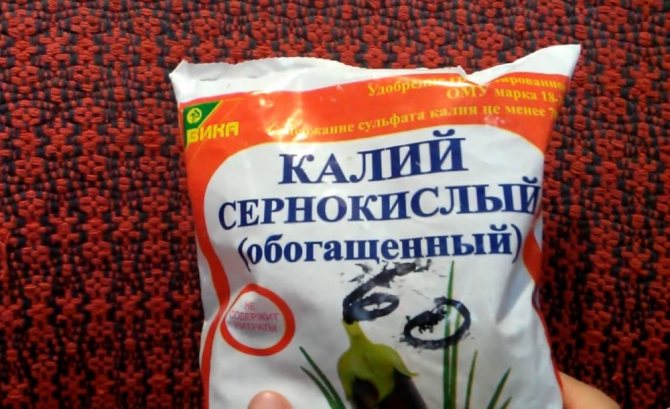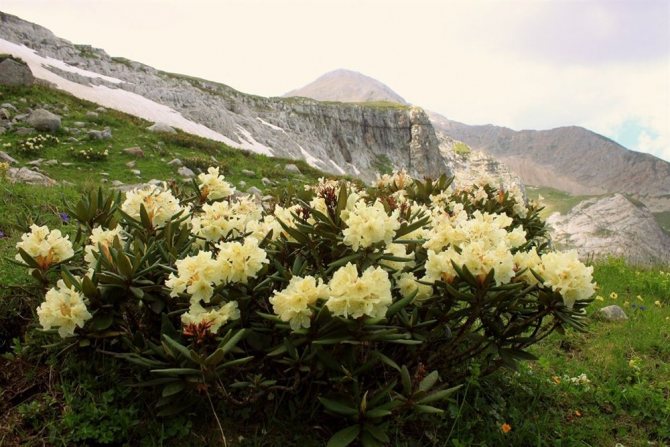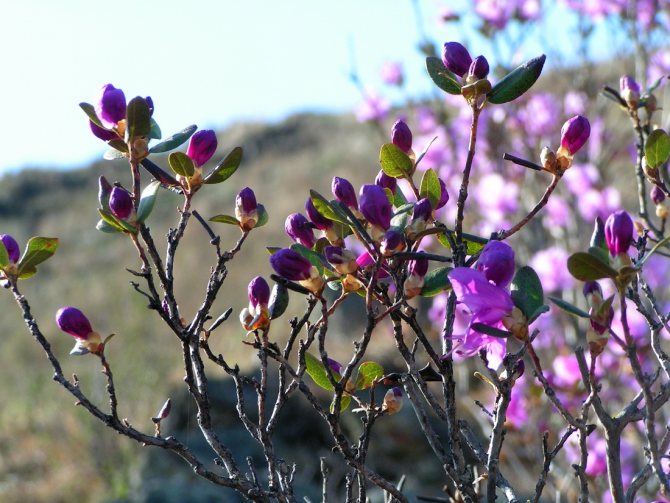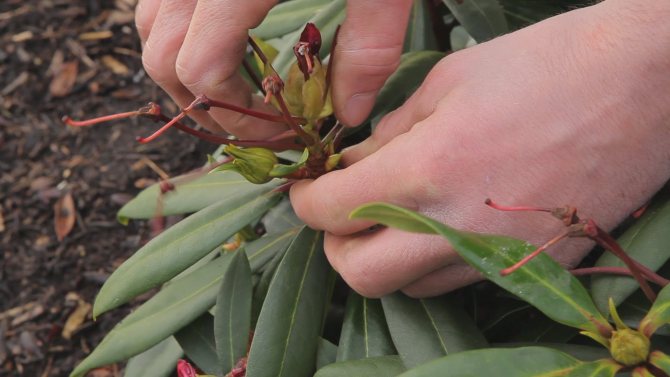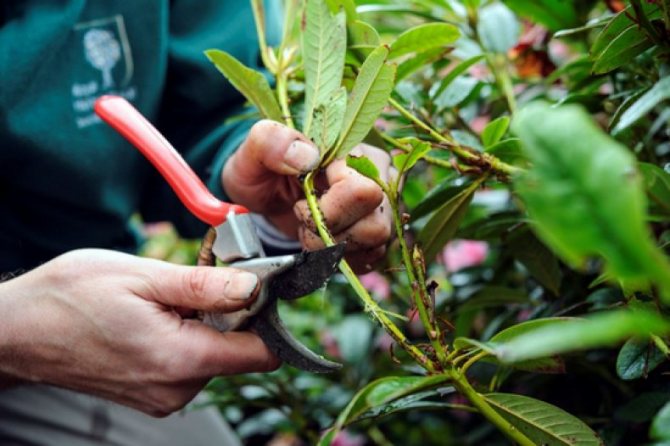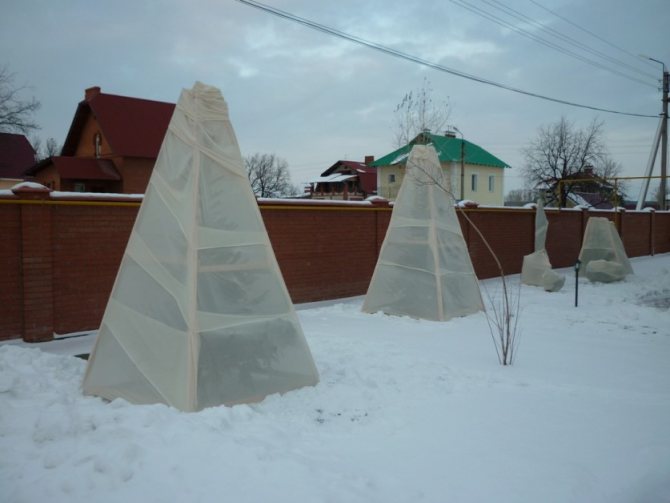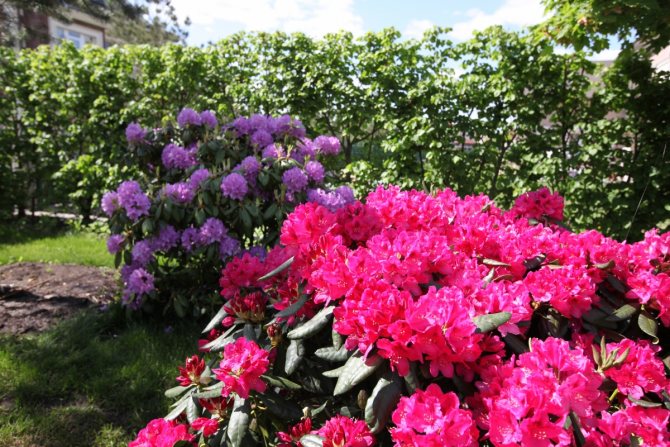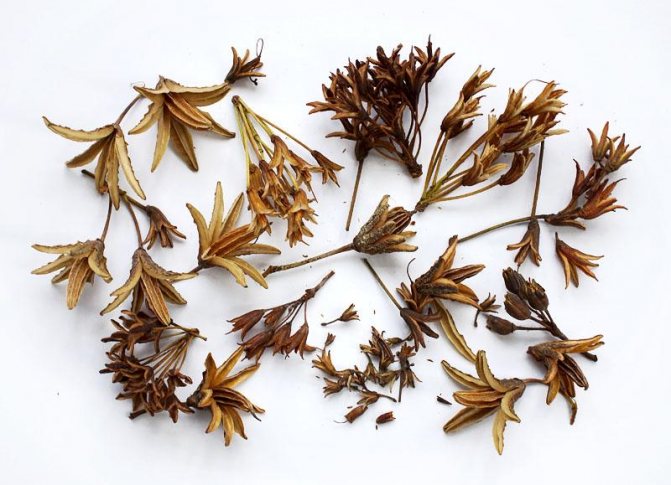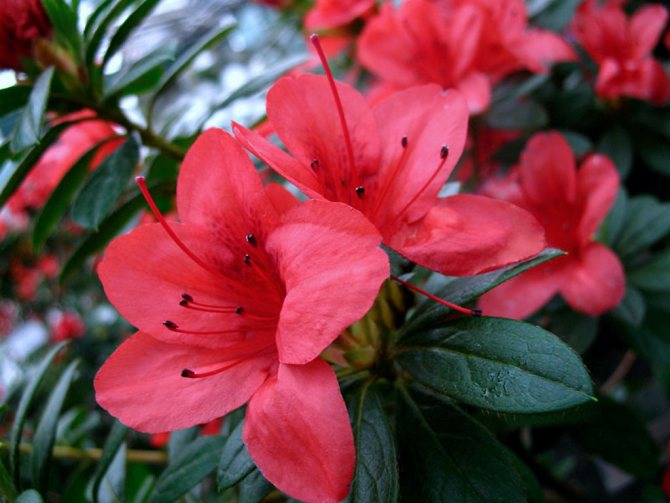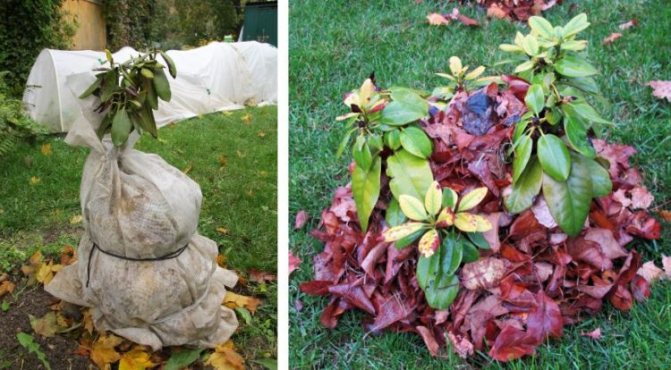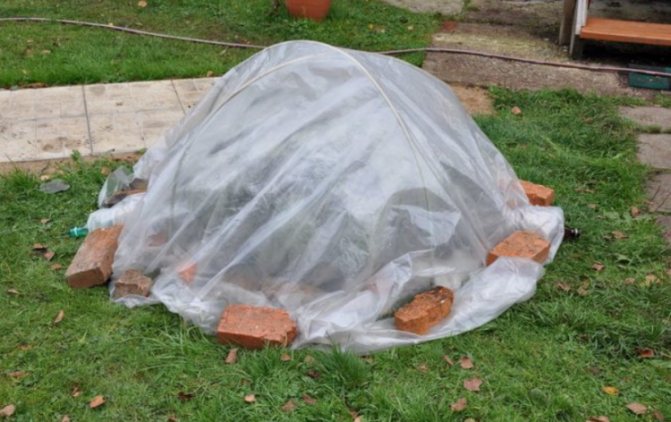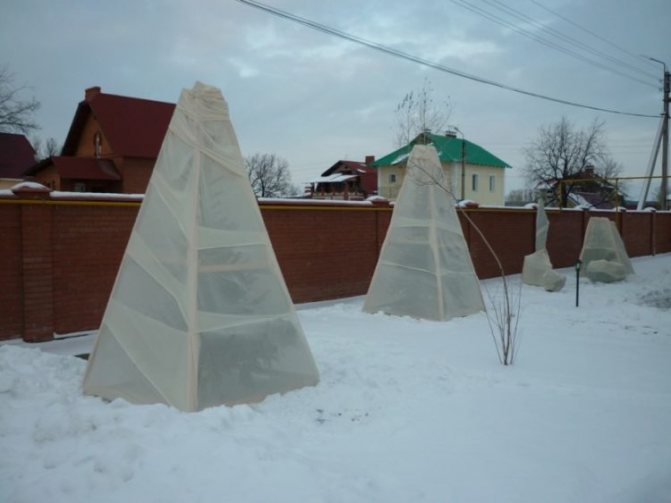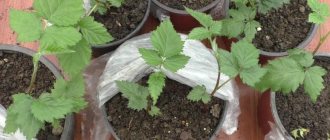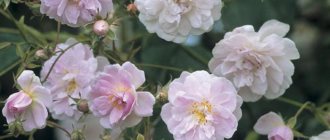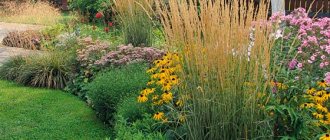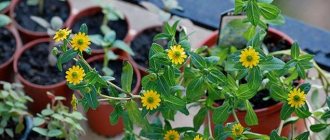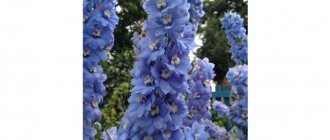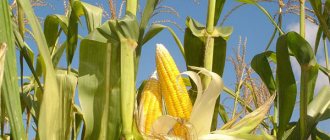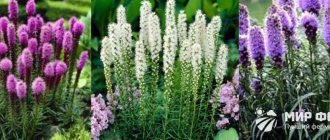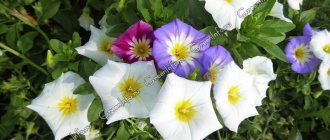Rhododendron is a very attractive plant. The flower has earned the attention of gardeners for its amazing lush flowering. It can be achieved only with proper planting and proper care of the plant. I would like such beauty to be on the site even in a region with a difficult climate. Many do not dare to grow rhododendron, considering the plant not hardy enough. Therefore, planting and caring for rhododendron in the Leningrad region is an important topic for gardeners in the Northwest region.
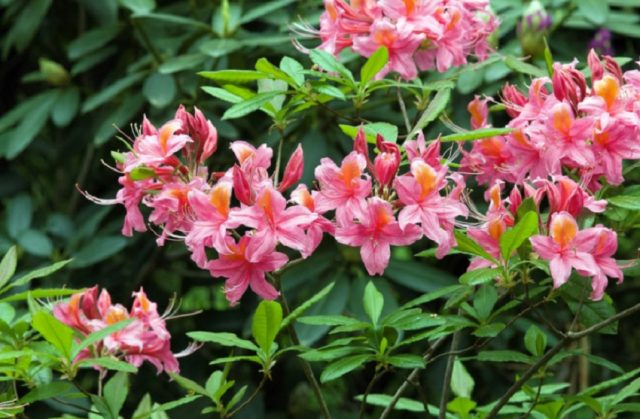
How to cover an evergreen rhododendron for the winter?
Evergreen rhododendrons do not shed their leaves with the onset of winter. For the most part, this species is quite winter hardy, but it is still better to build a shelter for the shrub. Under the weight of the snow cover, delicate shoots and flower buds can suffer, and the burning rays of the spring sun can damage the leaves. Usually, a wooden frame is built especially for these magnificent beauties, or, if the bush is short and wide, you can install arcs. On top of this structure, it is necessary to fix a white non-woven covering material (spunbond) with a density of 30.42 or 60 g / m2. It is possible to use less dense material, but under the weight of the snow it can suffer or break during dismantling, so you will have to buy a new one next winter.
- Install the frame in advance, before the soil is frozen. With the onset of cold weather, it remains only to cover the structure with spunbond.
- Punch a few small holes on top of the cover material. Then, in the event of a sudden thaw, the leaves and shoots of the rhododendron will not mate.
- Before the first frost, water the rhododendron bush well every 4-5 days (if the fall was not rainy). It will be easier for the plant to prepare for winter and survive frost.
And when do you need to cover the evergreen rhododendron? We have already found out that this shrub has good winter hardiness, therefore, you should wait with the shelter until the temperature drops to -10 degrees Celsius so that the bush does not sputter if warming occurs unexpectedly. But the removal of the covering material should be approached with caution. On the one hand, if you do not open the bush in time, it can undermine, and if you do it ahead of time, the sun's rays will harm the bush no less.
What to do in such cases? Experienced gardeners have long been using the partial shelter removal method. That is, for the most part, the bush has already been released, but some of the material is left on the frame on the south and west sides to protect the rhododendron from the scorching sun.
Shelter of evergreen rhododendron in the first three winters after planting is a must!
Plant preparation
The timing of the shelter of shrubs depends on the characteristics of the variety or hybrid. Before covering the rhododendrons for the winter, it is worthwhile to carry out several preparatory techniques that will help dicotyledonous eukaryotes survive the cold.
Top dressing
The plant needs to replenish the supply of minerals even at the end of the season. The process of ontogenesis of the rudimentary shoot of rhododendron begins from mid-August to the end of September. In order for the shrub to please with lush flowering in spring after wintering, until the temperature drops sharply in the root zone of the plant, elements important for growth and photosynthesis must be present.Only when all the substances necessary for growth are absorbed in autumn does the plant enter a dormant phase, reducing the rate of metabolic processes.
In order for all the processes necessary for entering the dormant phase to be completed on time, autumn dressings should not contain nitrogenous compounds that stimulate plant growth. In late autumn, with the onset of frost, granular fertilizers can be poured into the root zone of the bush:
- superphosphate - 25 g;
- potassium sulfate - 25 g;
- urea - 15 g.
During the winter, the granular substances will gradually dissolve, and with the onset of spring heat, they will be absorbed by the root system of the plant.
On a note!
Garden azalea feels very good when mulching the root zone in autumn with natural materials that will acidify the soil. The role of mulch can be performed by: needles of pine, spruce, thuja or juniper. And also just wood shavings mixed with a small amount of citric acid.
Pruning
The plant does not particularly need the formative shortening of the branches, since at the genetic level it has the growth of a symmetrical bush shape. Therefore, before the beginning of winter, the garden azalea should only be cut out of diseased and damaged branches. The only reason for shortening the bush is its rejuvenation. The procedure is carried out with the loss of decorativeness and lush flowering of rhododendron.
In the fall, before the onset of frost, the shoots of the culture are cut 5 cm above the level of the dormant buds. After pruning, after 10-12 days, the dormant rudiments will begin to grow, and in the next season the decorativeness of the garden azalea will be restored. To prevent the penetration of infection, immediately sprinkle the cut areas with wood ash or grease with brilliant green.
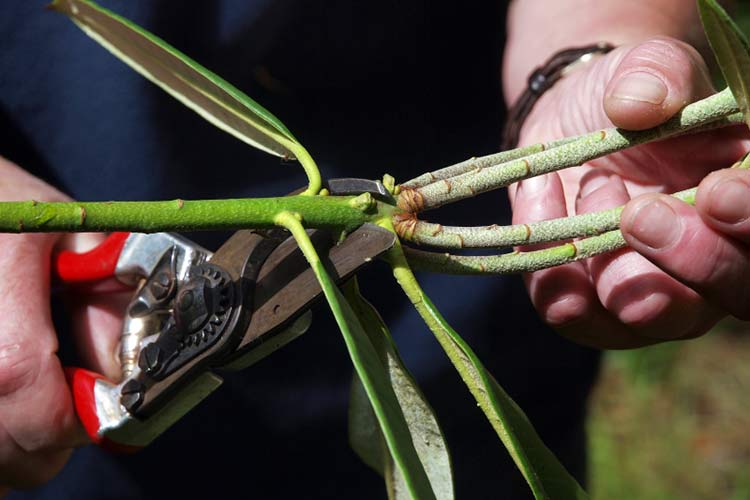

Treatment against diseases and pests
Rhododendrons, like all plants, have their own diseases and insect pests that can cause irreparable harm to the plant. Resistance to pathogens and insect parasites depends on the species and variety of plants. So, for example, evergreen varieties that grow in the sun are more susceptible to infections and pest attacks than those planted under the shade of trees. Emaciated plants are most susceptible to diseases, therefore, throughout the season, rhododendrons need to create optimal conditions for development.
Before the start of wintering in late September and early October, it is worth spraying plants with growth stimulants that will increase their immunity: Epin, Heteroauxin, Zircon. Before insulation with a covering material to prevent rot damage, treat the bushes with preparations: Fitosporin, Maxim, Fundazin, Effect, Previkur. To destroy the larvae of pests wintering on the foliage and in the soil under the plant, before warming, spray with insecticides: Aktara, Confidor Maxi, Oppercut, Aktellik.
On a note!
Some types of garden azalea have medicinal properties. However, most varieties contain toxins that specifically act on nerve cells, affecting nerve and neuromuscular tissues. Therefore, self-medication using rhododendron raw materials is strictly prohibited!
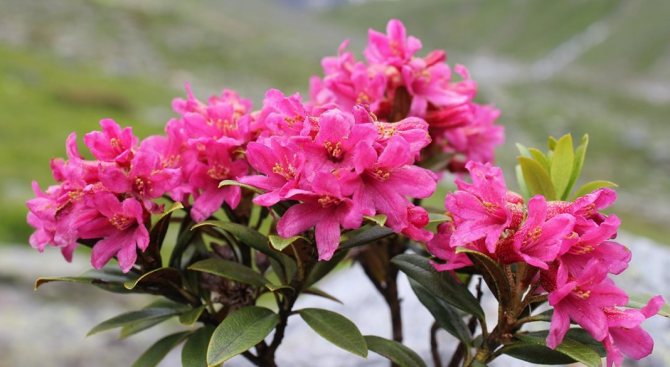

Shelter of deciduous rhododendrons for the winter
Deciduous rhododendrons tolerate the frosty winters of the middle lane quite staunchly, but shelter will not hurt them either. The fact is that not many varieties are able to survive severe frosts in the absence of snow cover, and this happens in our area. So, in order to protect the bushes from possible death, we recommend playing it safe. In this case, you do not need to build complex frames. It is enough just to drive a wooden stake into the ground next to the bush and cover it with a covering cap. Be sure to pay attention to the shelter of the rhododendron root system, which is superficial. The trunk circle should be mulched with peat or pine litter by 15-20 centimeters.When mulching, be sure to indent a couple of centimeters from the trunk, or the bark of your bush will resist by spring.
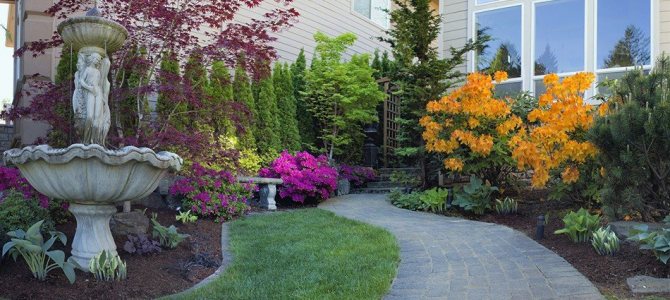

In the wild, rhododendrons are found most often in the northern hemisphere (in southern China, the Himalayas, Southeast Asia, Japan and North America), and therefore are a winter-hardy crop. By the way, this shrub is not rare on the territory of Russia: in the Far East, in Siberia, Karelia and on the Kola Peninsula. However, in the middle lane, winters are not always snowy, therefore strong winds and low temperatures in the absence of good snow cover can harm flower buds, individual shoots, or completely destroy the plant. This is why we recommend not neglecting the bush shelter during the winter months.
Covering materials
Each grower should select the most effective material for insulating shrubs individually, based on the climatic conditions of the region and opportunities.
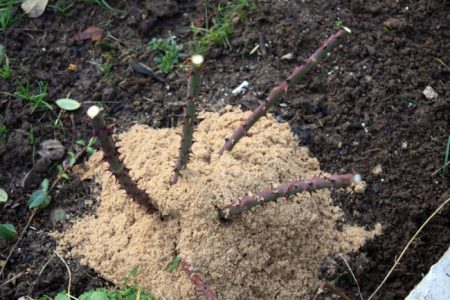

You may be interested in:
Dates of sheltering roses for the winter in the suburbs These are just novice gardeners who think that with the onset of autumn and after harvesting the work on the site is finished ... Read more ...
Lapnik
The branches of evergreen trees and shrubs are the most affordable material for sheltering a garden azalea. The constructed insulating hut does not get wet, creates an air gap, retains snow well and protects from severe frosts. In addition, the specific smell of spruce branches scares away rodents, so this material is especially valuable when sheltering young bushes. Covering rhododendrons with natural material for the winter, growing in sunny areas, is to protect shrubs in the spring from ultraviolet burns.
Dry corn stalks
Another natural material that can be used to protect perennials from frost. However, during heavy rains, the corn stalks should be covered with plastic.
Sawdust
Wood shavings protect the surface root system of the plant well from frost. However, it is not recommended to cover the shrub completely with it. It is best to sprinkle it near the rhododendron in a layer of 20-30 cm. In heavy rains, cover the sawdust with polyethylene, and before filling them in the root zone of the culture, stir with a small amount of citric acid.
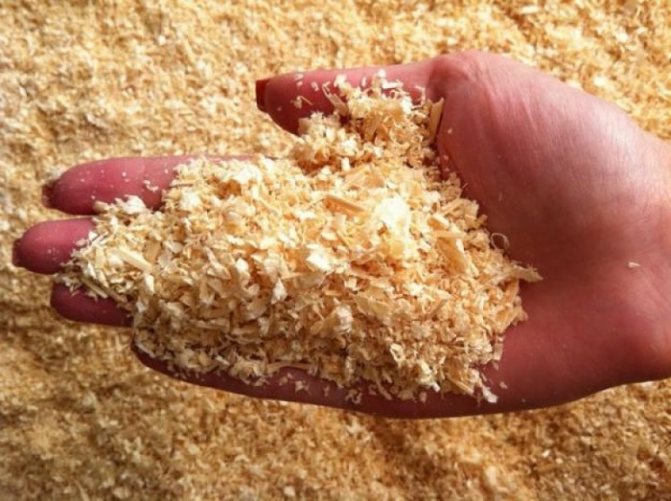

Thermal insulation decks
Thanks to the unique properties of thermally bonded geosynthetics, rhododendrons in the northern regions can be protected. Thermal insulation materials are moisture-permeable, so it is recommended to stretch them under polyethylene. Such a "greenhouse in a greenhouse" is suitable for sheltering ornamental shrubs in the Leningrad region and Siberia.
Protective structures
Designed to protect plants from the cold, the structures protect shrubs from harmful UV radiation and rodents, and allow air to pass through well. Mini greenhouses include dense agrofibre and metal arches, insulated with PVC braid. The structures are made of alloys that are resistant to corrosion and exposure to subzero temperatures. In such a covering cover, rhododendrons do not freeze out, receiving the oxygen necessary for a comfortable wintering.
On a note!
Plants that have lost a large amount of moisture during the wintering period have folded leaves and drooping branches. To restore the decorative effect of the shrub every three days, spray the leaves with a solution of the growth stimulator Epin or Heteroauxin.
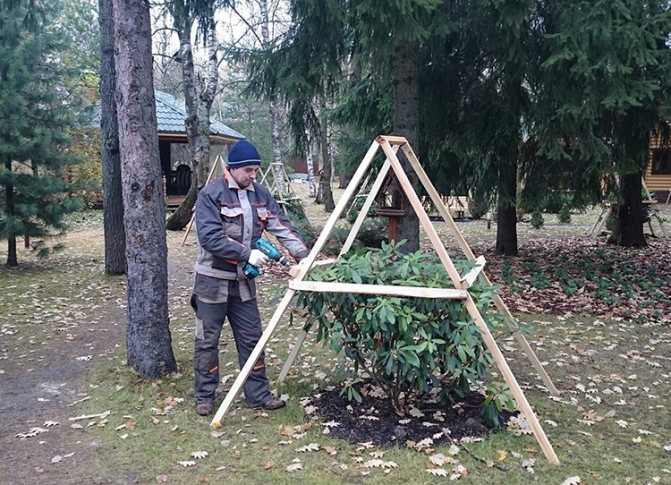

Shelter azaleas for the winter in the suburbs
Rhododendrons adorn gardens with their vibrant flowers of a wide variety of colors. Many different species and hybrid forms of the genus Rhododendron are called rhododendrons. Among them there are both undersized shrubs and small trees. Rhododendron flowers can be white, purple, red, pink, or bright yellow.To grow a beautiful and amazing plant called rhododendron in your summer cottage in the Moscow region, you need to know what subspecies of this tree exist and how to properly care for them. In this matter, the study of the origin of the exotic shrub and its natural habitat will help.
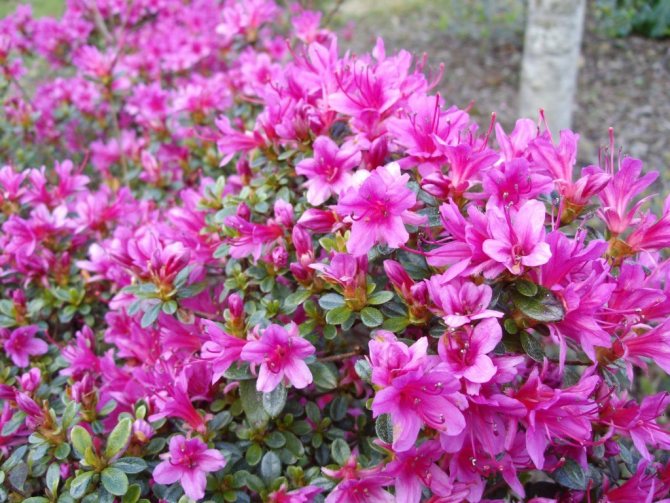

Description and features
Rhododendrons are one of the brightest representatives of the heather family. They like to grow in humid climates, for example, in the coastal zone of water bodies, as well as on the slopes of mountains, as the lower layer of the forest. Depending on the species and variety, rhododendrons grow as a deciduous, semi-evergreen, evergreen shrub or tree. Their height ranges from 10 centimeters to 30 meters.
Rhododendrons differ from each other not only in height, but also in the shape of leaves and inflorescences. The color of the buds varies from white and yellow to pink, and even purple shades. In some species of rhododendrons, the flowers have a delicate floral scent. At the end of the growing season, fruits are formed, inside of which there are small seeds. The plant attracts bees and is an excellent honey plant.
Additional Information. Large-leaved rhododendron was chosen as the state symbol of Washington.
Choosing a variety of rhododendrons
Of course, tropical varieties are distinguished by stunningly large and beautiful flowers, however, choosing them for your garden is strongly discouraged. This is due to how difficult it is to grow rhododendrons in the suburbs. Planting and care is complicated by climatic conditions, fluctuations in day and night temperatures, frost and lack of necessary humidity. Our fellow citizens who have moved to England note that the cultivation of these whimsical plants becomes a simple pastime.
Fresh articles about garden and vegetable garden
That is why we pay attention only to the strongest and most resistant to natural anomalies varieties. Of the huge number of varieties (about 600), there are only about 18 such species, all of them grow on the territory of the former USSR and are on the verge of extinction. Many are listed in the Red Book.
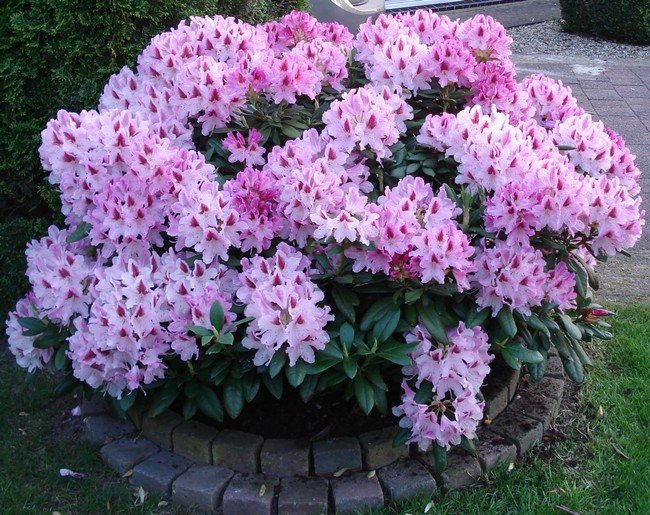

Reproduction: growing street Azalea from seeds and not only
The garden azalea is propagated by seeds, cuttings, layering and dividing the bush.
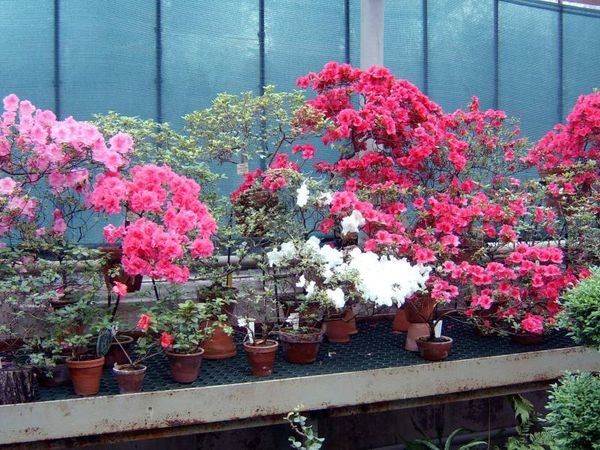

The choice of breeding method depends on how quickly you want to get the result.
The easiest way is to lean the side shoot to the ground, fix it with wire, sprinkle it with earth and water it regularly. After a while, it will take root, and next spring the young bush can be separated from the mother plant.
Divide the bushes with a vein before the start of sap flow. With the help of a sharp object (spatula, spatula), part of the bush is separated and transplanted to a new place. In this case, the mother bush should have a well-developed root system and several healthy shoots.
Propagation by cuttings takes from 1.5 to 4 months from the time of cutting the cuttings to their rooting. To achieve the result, you need to follow the recommendations of experienced gardeners:
- Cut the apical cuttings 10 cm long. The apical bud and lower leaves removeleaving 2-3 healthy leaves.
- Treat the sections with a growth stimulant. Embed the cuttings by 2-3 cm in individual pots or cups filled with a mixture of peat and sand. Moisten the soil.
- Cover the cups with cut-off plastic bottles to create mini greenhouses. A week after planting the cuttings, begin airing by unscrewing the lids or removing the caps daily for 10-15 minutes.
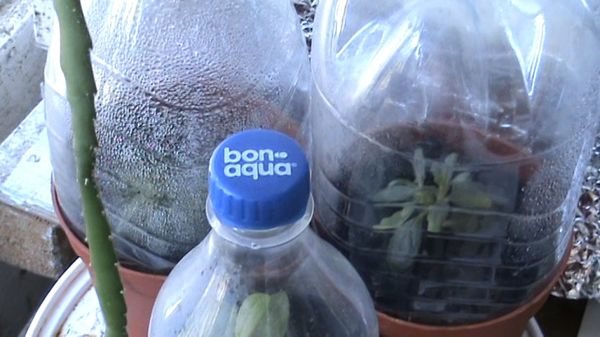

Micro greenhouses help maintain the right temperature
- For successful rooting, maintain an air temperature of + 20 + 24 ° C and water as needed, not forgetting to drain excess water from the trays.
- After rooting, transplant the cuttings into a container with fertile acidic soil.
- Plant in a year to a permanent place in the garden.
Propagation by cuttings is a troublesome and time-consuming process, but it has its advantages.If a neighbor in the country cuts cuttings from his bushes, you will immediately see which plant will bloom in your garden in 3-4 years.
The seed method of reproduction is practically not used by gardeners - with this method of reproduction, you will have to wait a long time for the first flowering.
Lovers of growing plants from seeds can try to germinate them in an impromptu daily ventilated greenhouse, keeping an eye on behind the substrate moisture.
Choosing a place for planting rhododendrons
It all starts with determining the permanent residence of the rhododendron. This is an important point, since the plant will die if the conditions close to its native habitat are not met. Most of all, it prefers places where it is observed:
- lack of wind and drafts;
- shading from sunlight;
- elevation (for water drainage).
It is preferable to plant from the northeastern side of the house - this will provide the necessary protection. In lowlands with the presence of stagnant moisture, the plant begins to wither and gradually dies. When planting in open ground in the fall, it is better to cover new seedlings so that they do not freeze in winter.
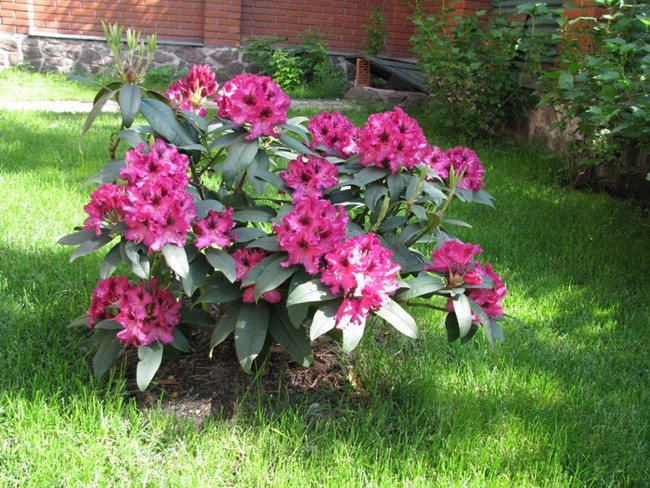

Possible errors and their consequences
Possible mistakes when pruning rhododendrons are listed below.
- Summer pruning too late. Pruning branches in the second half of summer is fraught with the fact that it is possible to provoke an increased growth of shoots from the buds, which the plant laid for the next year. In this case, the bush may even bloom before winter. Young shoots will not have time to prepare, overgrow with dense bark and acquire winter hardiness.
- Over-pruning throughout the season can have the same consequences. The shoots have dormant buds that have been dormant for many years. From excessive pruning, they can wake up, and the bush will quickly begin to age, complete the full cycle of its development with possible death. To avoid the negative consequences and death of the shrub, it is necessary to adhere to the rule of moderation in pruning branches.
- In addition, you should try to trim over the buds, making neat cuts. If cuts are made high above the buds, then part of the shoot dies off, and the bushes take on an untidy look.
- Only strong ovaries are selected to collect seeds. They are left, and around the dried perianths and parts of flowers are manually removed. If it is necessary to carry out targeted pollination, then gauze bags are put on the flowers in order to avoid accidental pollination by neighboring bushes. Pollination of flowers is carried out manually with pollen of selected forms. This is a very interesting activity, although the result will have to wait a long time. It takes 4-5 years for a new plant grown from a pollinated seed to bloom.
For your information! You should not be afraid of pruning rhododendrons. From this, the bushes will acquire an even more aesthetic appearance, and the entire site will look spectacular and will significantly add value.
Caring for rhododendrons after planting
After planting for two weeks, it is advisable to shade the rhododendrons. To do this, I put the arcs and fix the non-woven fabric only on the south side, from the north it is advisable to leave the plants ajar for air access. Neither in the year of planting, nor the next year, the plant will not bloom or will give it meager flowering, but in subsequent years it will thank in full.
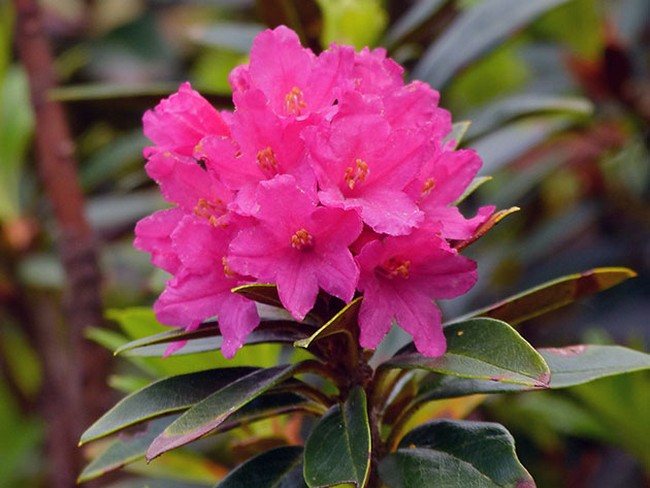

Differences in the life cycle at different times of the year
The entire life cycle of an azalea, its growth and flowering strictly depends on the change of seasons. In spring, along with warming, the period of flowering begins, in summer there is a rest, and then the growth of the plant, autumn is the time for laying flower buds, which, with the arrival of winter, develop and become flowers.
Autumn is an important period in the life of a plant, when future buds are formed. If at this time you do not provide him with proper care, then flowering will be very scarce or not at all.
For information on how to provide the necessary care for your azalea at home after purchase, read here.
Watering and spraying rhododendrons
Evergreen and semi-evergreen rhododendrons need high humidity, they will be grateful for planting near an artificial pond with a fountain or by a reservoir. If this is not possible, it is advisable to spray the plants with water using a sprayer or spray hose as often as possible, especially in the heat. When using tap water, you need to be careful, for the first seconds hot water can flow, especially if the hose is in the sun, so it must be drained so as not to burn the plants. It is convenient not only to douse the plants with a hose, but also nearby trees and paths to create additional moisture.
Fresh articles about garden and vegetable garden
Advice
In order to avoid mistakes when preparing rhododendrons for winter, you should adhere to the recommendations of experienced florists:
- it is generally impossible to water rhododendrons during wintering, gradually reducing the supply of fluid from the beginning of autumn;
- you should not remove the insulation material from the bushes as soon as the snow melts. The procedure should be carried out after warming up the soil and there is no threat of spring temperature drops to the minus mark;
- insulating shrubs, take care of flower buds and preservation of apical shoots. The procedure is performed by bending the branches to the ground. Despite its massiveness, even adult bushes tolerate such an inclination well;
- check shelters throughout the winter: brush off excess snow, replace wind-damaged agrofibre in time;
- if the plant is sheltered too early, the transition zone from the root to the stem will begin to rot, the foliage will be covered with mold spores, and the bush will die. To prevent decay, open the covered garden azalea from the sunny side. After keeping the bush wide open for two weeks, when a stable subzero temperature is established, cover it again.
With proper insulation of "pets", they will winter without problems. And in the spring they will delight the owners with lush bright flowers.
Pruning rhododendrons
Rhododendrons do not really need pruning, as they can naturally form the correct shape. But it is still necessary sometimes to trim overly tall shrubs, remove dead shoots and generally rejuvenate the bush. First of all, start this procedure at the very beginning of spring, until the juice begins to move along the stems. In the place where the stems are 2-4 cm thick, the cuts must be processed with garden pitch. After that, buds will begin to appear in those places, starting the renewal process. As for old and heavily frozen shrubs, they need to be cut at a height of 30-40 cm from the ground. During the first year - one half of the bush, during the second - the other.
What fertilizer to use for rhododendrons
The ornamental culture does not make high demands on soils, since there are no highly fertile areas in its natural habitat. But it cannot be left completely without fertilizers. Indicators that it is time to apply top dressing are growth retardation, a decrease in the number of buds, pale foliage and flowers. If yellow spots appear on the leaves, their surface turns brown, becomes thinner and torn, then this indicates a lack of nitrogen and potassium, with reddening of the leaf - a lack of phosphorus.
In spring, ammonium nitrate, 30-40 g per 1 m² of the trunk circle, is effective for high-quality care of rhododendron and activation of growth processes. After flowering and trimming the ovaries, fertilizing is given in the form of Azofosk mineral fertilizer in a dose of 20-30 g per 1 m². In August, superphosphate (15-20 g) and chlorine-free potassium fertilizer potassium sulfate - 15-20 g per 1 m² are needed.
Diseases and pests of rhododendrons
The plant has quite a few enemies, and with your connivance, they can destroy a wonderful bush in a short time. What pests are attracted to rhododendron? I will name the most popular ones:
- snail;
- shield;
- slug;
- spider mite;
- rhododendra fly;
- mealybug.
You will have to pick up snails and slugs by hand, with the necessary patience. Get insecticides and karbofos from other pests. Preventive fungicide treatments will help prevent the appearance of insects.
What diseases threaten rhododendron? Most often these are fungi. You need to deal with them skillfully - remove all affected shoots to a healthy clean tissue and treat the bushes with copper sulfate. Here, too, prevention will not be superfluous. To carry it out with Bordeaux liquid several times per season.
Mulching and feeding
For mulching the bushes, crushed pine bark, fallen needles, steamed sawdust, small expanded clay, peat or tree foliage (except for chestnut and maple trees) are used.
Mulching retains moisture in the ground, prevents weeds from growing, protects surface roots from overheating in summer and from freezing in winter. When mulching, the root collar should be free.
Without feeding, there will be no abundant flowering, and for the normal growth of azaleas need additional food... There should be several dressings during the summer:
- In the spring, add a solution of mullein (humus) in a ratio of 1:10.
- At the time of bud formation, a second mullein feeding is carried out with the addition of phosphorus-potassium fertilizer.
- When the last buds fall off, carry out the third feeding with phosphorus and potassium in a ratio of 1: 2.
- Top dressing is applied at a distance of 0.2-0.3 m from the center of the bush.
When applying complex fertilizers, it is necessary to ensure that they do not contain chlorine and lime... Also, you cannot use wood ash - it changes the acidity of the soil, reducing it.
Shelter of rhododendrons for the winter
It happens that autumn does not spoil us with rains. Do not stop watering the bush, but slightly reduce the amount of water. If there is enough rain, then additional moisture is not needed. In the fall, lay a thick layer of peat around the rhododendron for extra insulation.
Looking forward to a frosty winter? Do not rely on the firmness of the plant, but collect the shoots in a bunch, tie them with twine and wrap them in burlap. Extra precaution will not hurt if you do not want to risk your pet. In the spring, do not be late with the removal of the cover, small frosts do not pose a threat. Immediately carefully inspect the plant and remove frost-damaged shoots.
Soil and planting
Azalea will grow well only on loose and acidic soils, in which sand, peat and coniferous soil are present. The acidity of the soil is necessary constantly maintain at the level of 4.0-4.5... For planting a seedling, early spring is suitable before the juice begins to move or the beginning of autumn - the bush will have time to take root in a new place before the cold weather begins and will normally endure the winter cold.
Garden azaleas have a shallow root system, so they don't need a deep planting hole. However, planting seedlings has some nuances:
- Dig a landing hole 0.5 m deep and 0.6-0.7 m in diameter.
- Lay a 15-20 cm drainage layer of sand, expanded clay and broken brick at the bottom of the pit - it will acidify the soil. It is undesirable to use limestone materials (crushed stone, crumbs), otherwise alkalization of the soil is inevitable, which azaleas do not tolerate.
- Mix the soil taken out of the pit with peat, humus and coarse sand to increase looseness and soil permeability.
- Pour the soil mixture onto the drainage layer and place the seedling on the hill, controlling the level of the root collar - after planting it should be slightly above the soil level.
- Gently fill the root ball with soil, compact the soil around the seedling, add soil and water if necessary.
- Mulch the soil around the bush with moss, peat, pine needles or crushed bark - mulch will prevent the growth of weeds and retain life-giving moisture in the soil.
Plants in containers can be planted throughout the summer, when removing from the container, the earth must not be crushed from the roots.Saplings purchased from nurseries or garden centers should be watered abundantly before planting.
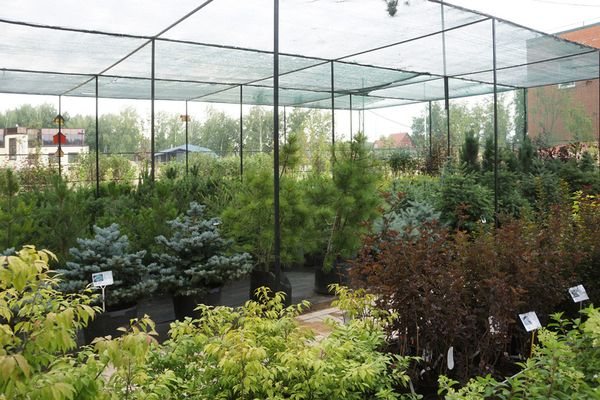

It is highly recommended to water the plant bought from the nursery abundantly
You can dip the root ball into the water for a while until air bubbles stop appearing from the water.
Purchase seedlings in a large container, the size of which corresponds to the total size of the plant - in small containers, the roots do not develop well.
When buying, check the agrotechnical characteristics and check the viability of the bush: its branches should be elastic, healthy and strong. Sick and weak seedling it will not be possible to leave.
Photo
Next, you can see what a garden azalea winter shelter looks like.
Do you make a "house" yourself or buy a ready-made one?
If there is no time or opportunity to make the covering structure yourself, you can buy it. Garden stores sell inexpensive pre-made rhododendron sheltersconsisting of a wire frame and a cover made of garden sheeting batting. They are easy to use: the plant can be quickly covered and quickly closed.
However, according to gardeners, the frames of such structures are not very strong. Therefore, if you have time, desire and the necessary materials, you can make a "house" for the rhododendron yourself.
Soil requirements
Rhododendron in nature lives in loose acidic soil with a high humus content. To grow a crop in a garden plot, it is necessary to prepare a fertile mass with the appropriate characteristics, paying attention to individual points.
Rhododendron loves acidic soil with a pH reaction of up to 4.5. In alkaline soil, the seedling has practically no chance of development. Moreover, in areas with a neutral pH, the culture does not grow well, it will not be able to please even with meager flowering.
The optimum potting mix for rosewood consists of high peat, coniferous decay and leafy soil in a 2: 1: 3 ratio. You can also use a substrate of equal parts brown peat and pine or spruce decays. To acidify low-lying peat, sphagnum moss, ammonium, potassium sulfate or other acidic fertilizers are added.
The composition recommended by experienced florists for planting rhododendron:
- heather land from under the conifers;
- garden soil or river sand;
- rotted cow dung;
- humus. Aged compost can be used;
- coniferous mass.
The mixture consists of the same proportions of ingredients. To the finished substrate add 100 g of fertilizer "Kemira-universal". If necessary, you can purchase targeted soil for rhododendrons.
The soil for the "rosewood" must be breathable. When planting a plant in a clay area in a pit, make good drainage. In places with a close location of groundwater, a small hill can be built under the rhododendron to exclude spring flooding.
Choosing a method of insulation
To better understand how to cover a rhododendron for the winter, be sure to watch the video in our article. But first, you need to figure out the way that it will be more convenient for you to use. So, the choice of the method of insulation, as has already been mentioned more than once, depends on the variety and age of the shrub. So, young one-year-old bushes are covered with a cardboard box, having previously well mulched the soil around the stem. For air circulation, holes should be made in the side, and the film will protect the compressed paper from getting wet. In addition, you can build a kind of "house" from spruce branches. It is better not to use hay and straw, as rodents grow in them.
Excessive shelter leads to rotting, and the plant will die. Work on the shelter should be started no earlier than the ambient temperature drops to -9 ° C.
The next method is to create a mini greenhouse.In this case, metal or plastic arcs are pre-installed above the bush, it is better to do this in early autumn, and with the onset of cold weather, a protective material is pulled onto the frame in at least two layers. Mainly, artificial agrotex, lutrasil, etc. have found their application. But you can also use spruce branches with dry foliage.
The size of the frame depends entirely on the size of the shrub. There should be a distance of at least 15 cm between the plant and the insulation. Otherwise, bending under a layer of snow, the material can damage the branches. Contact is not yet desirable, and due to the fact that lutraxil will cool down and in places of contact will provoke more freezing. Arcs are usually installed after 35 cm from each other. Also, a layer of film is also laid on top of the selected material, it will become reliable protection from both gusts of wind and from getting wet.
To strengthen the structure, you should thoroughly sprinkle the edges of the agrotex with a film with soil or put bricks on them, in general, any heavy object will do. One of the ends of the resulting tunnel is sewn up tightly, but the second remains free to ensure air circulation, it closes only with the arrival of constant frosts. The advantages of such a shelter include additional protection from the scorching spring sun, which can inflict unwanted burns on the leaves of the bush.
If there is no time and desire to build a greenhouse, you can simply sprinkle the plant with snow or cover it with dry foliage, there should be no problems with stunted species, but the branches of tall shrubs should simply be bent to the ground. In principle, the designs of protective "houses" for rhododendrons can be different, some ideas can be seen in our video. The main thing is that the shelter is light enough, reliable, of course, warm and prevents the penetration of winds and moisture.
There is no absolutely unambiguous answer to the question about the shelter of rhododendrons for the winter. If roses must be covered, then rhododendrons, for example, grow well uncovered in Finland. It is very important to consider the location of your site.
The harsher the climate in your area, the more it tends to continental, the greater the need to shelter rhododendrons
.
In a maritime climate - in St. Petersburg, in the Baltic States - you can leave adult rhododendrons without shelter. Small rhododendrons up to three to four years old should be sheltered in any area. This is not difficult to do, since rhododendrons at this age are not yet very wide and tall.
Feeding rhododendrons: basic recommendations
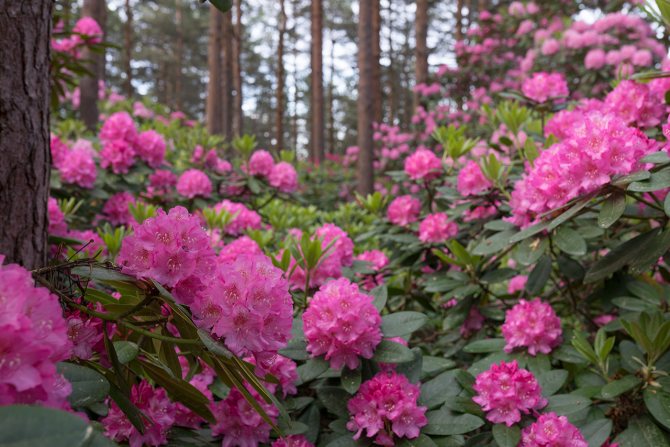

Rhododendron is sensitive to feeding, so using a mixture of minerals and organics at random is far from the best idea.
When feeding bushes, the following rules must be observed:
- for young plants, use liquid formulations that are quickly absorbed by the root system;
- avoid dressings that reduce the acidity of the soil (ash, etc.), since the rhododendron will suffer from chlorosis;
- give up preparations with lime and chlorine - they cause irreparable harm to the root system;
- the introduction of superphosphate should be carried out in moderation to avoid leaching of iron from the soil.
The lack of trace elements inevitably leads to the loss of decorativeness of the rhododendron - the leaves turn yellow, become stained, young shoots do not form, and the buds freeze and fall off.
When planting a bush in a nutrient soil, top dressing is resumed in the second year of cultivation, so that the supply of necessary substances does not dry out.
What happens if you stop fertilizing rhododendron
The answer to this question is quite simple. At first, rhododendron develops on soil containing mineral elements. It blooms beautifully and emits a pleasant aroma. Then they stop fertilizing the soil. Nutrients are gradually depleted. The acidity of the soil decreases.The plant loses its decorative appearance, gets sick and, with the most negative result, dies.
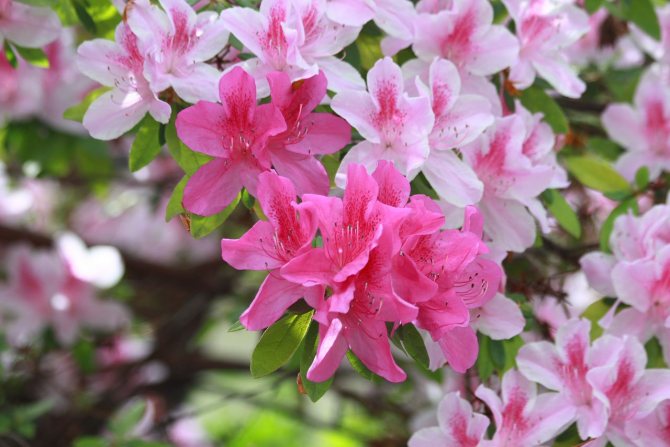

The beauty of bloom as a reward
Thus, flower beds in gardens are designed to please, create spiritual harmony. But to achieve this, it is worth the work. Growing rhododendrons, gardeners must take into account the needs of the plant, its whims. Only then will it endow them with its bright flowering, splendor, aroma.
How to prepare a plant for wintering?
Preparation for the winter of non-frost-resistant hybrids is carried out in several stages.
To make a decision about the right shelter for the winter, you need to determine the type and age of the plant. One of the hybrids of rhododendron is, which requires strict adherence to the rules of caring for it. The fact is that some can easily withstand a drop in temperature to minus 30. Young plants of any species up to three years old should be covered in any case.
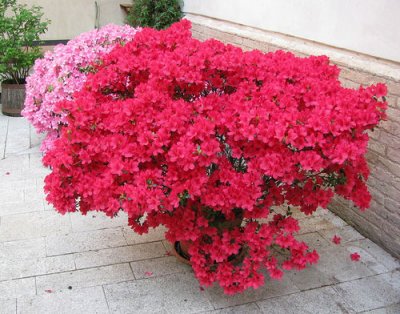

Firstly.
In the fall, carry out water-charging irrigation. It is necessary, since rhododendrons also evaporate moisture in winter, as in summer. They need a supply of water in winter.
A gardener in this matter should be guided by a specific situation. If there is enough autumn rainfall, there is no need for additional watering. In the event that the autumn months are dry and hot, you should water the bush at the rate of a bucket as the soil dries up.
After watering, it is imperative to mulch the surface so that all the moisture gets to the roots, and does not evaporate. Continue watering even after the onset of cold weather, and stop only when the ground is frozen.
IMPORTANT!
Use only soft water for irrigation. Admixtures of lime, chlorine and iron are detrimental to the plant.
Secondly,
feed the plant with potassium fertilizer, this will ensure the ripening of the growths. Do not apply nitrogen fertilizers under the rhododendron in the fall. This will force him to give new shoots, and he will not have time to prepare for the winter. This means that it may not winter.
Sometimes the weather is too warm and rainy in autumn. Bushes start to start young shoots.
This is bad, since they will not have time to mature and will die in winter conditions. To prevent this from happening, treat them with 1% sodium sulfate solution.
After such treatment, lignification of the stems will occur and flower buds will be laid on them. It is also useful to add iron, colloidal sulfur. It will acidify the soil and prevent the development of fungi in it. Before wintering
treat the bushes with phytosporin or copper sulfate.
The area around the bush should be carefully covered with a protective pillow. Use peat, pine needles, sawdust for this. For young low-growing plants - up to 50 cm - a layer is needed 5-6 cm, and for tall ones - up to 20-30 cm.
Advice
- do not remove fallen leaves from under the bushes, pulled out weeds - they will also fulfill the task of mulching the soil. The diameter of the mulched surface is equal to the diameter of the crown.
So that there is no stagnation of moist air, a piece of a thin pipe, preferably flexible, can be placed under the film, which will serve as an air outlet.
Rhododendron very afraid
accumulation of melt water under the bush. Therefore, place an earthen mound around it and a groove at some distance from the base. During thaws, make sure that the water does not leak under the bush, drain it in time.
How to insulate each type of garden azalea?
Rhododendron has about 600 species. These also include the well-known Azalea gardeners. They are classified into evergreen and deciduous species. When preparing for the winter of different species, it is necessary to take into account their characteristics. However, for all types of rhododendron, mulching is a prerequisite in preparation for winter.
Deciduous species of rhododendron overwinter well in the middle lane. In especially snowy winters, you don't even need to cover them, but if there is not enough snow or the plant is still too young, it is better to do it anyway.
After all the leaves have fallen, buds remain on the branches - these are flowers that will bloom next spring.
They need to be protected from the sun in late winter - early spring. For this, a hut built of a wooden frame and lightweight covering material is quite suitable.
The leaves of evergreen varieties of rhododendron at the first frost curl into tubes and sink. So the plant independently begins to prepare for winter. At the same time, evergreen varieties of rhododendron still need more serious shelter, since moisture evaporates from them even in winter. For the shelter of such varieties, a non-fragile porous insulating covering material, for example, expanded polypropylene, is better suited.
The evergreen varieties include the Kazimierz Odnowiciel hybrid rhododendron.
It was bred by crossing Finnish varieties, resulting in a winter-hardy variety that can withstand temperatures as low as -30. It is necessary to plant it in partial shade, which will also make it easier to transfer the bright light of the winter sun.
Among deciduous varieties, Japanese rhododendron has gained particular popularity. This is one of the brightest decorative varieties of rhododendron. At the same time, it is quite frost-hardy, but it is also better to cover it for the winter.
Main problems
The main problems that garden azalea faces in winter are desiccation from cold and wind and the likelihood of root rot. Proper preparation for winter, taking into account the above rules, will help prevent problems.
At first glance, rhododendron may seem like a capricious plant, but the rules for caring for it are not so complicated. If you prepare a garden azalea for winter, and make a shelter, you can preserve the health and beauty of a shrub that can overwinter and bloom profusely in spring.
Rhododendrons are different - heat-loving and frost-resistant, tall and short, natural or bred by breeders, evergreen and deciduous. All of them, without exception, are a wonderful decoration for your garden. But some of the rhododendrons in the fall need to be more thoroughly prepared for the cold.
The peculiarities of the rhododendron shelter for the winter will be the subject of our today's article.
You won't be lost with them.
It has been established that, to one degree or another, the middle zone of Russia is suitable for about 40 species of rhododendrons. As for varieties, this question remains open, as it requires careful and comprehensive study. Variety study, I note, must be specific, that is, cultivars must be tested not only in different regions, but on different soils, with different humidity and light conditions. So far, only the species rhododendrons have been more or less studied, which, by the way, for the most part in their decorativeness are not inferior to varietal plants.
Here are just some of your possible settlers. Seventeen of the most winter-hardy and unpretentious species of rhododendrons, recommended for amateur gardening in the Non-Black Earth Region.
Rhododendron Vasey (R. vaseyi) is a deciduous shrub, in culture it is usually no more than a meter in height. Originally from North Carolina, USA. Fully winter-hardy, although flower buds are sensitive to spring return frosts. Because of this, it works better where the soil thaws in the spring and warms up later. The flowers are funnel-shaped, light pink with brownish-red dots. Blooms before the leaves open. The soil should be moist but permeable.
Dahurian rhododendron (R. dahuricum) is deciduous, but sometimes some of the leaves at the top remain to winter on the plant. The usual height of the bush is about 70-90cm. Leaves ovate-elliptical 5 × 2cm. The flowers are lilac-pink, broadly funnel-shaped. It blooms in early spring in a leafless state around a crescent.
It grows well in ordinary garden soil, if you add high peat to it. In nature, this species is widespread in the south of Eastern Siberia and the Far East. It is he who is most often called "wild rosemary".
Rhododendron yellow (R. luteum) is a deciduous, spreading shrub 70-90 cm high. Grows in the Caucasus and the Carpathians. One of the most reliable and unpretentious rhododendrons.It grows well in the light, on ordinary slightly acidic and neutral soils with the addition of peat or heather soil. The flowers are golden yellow with a pleasant aroma. Blooms in spring at the same time as the leaves open.
Rhododendron golden (R. aureum) - evergreen, 0.3-0.5 m high, up to 60-100 cm wide. Distributed in the south of Siberia from Altai to Kamchatka. It grows in the mountains, in the upper part of the forest belt and above. Leaves are elliptical, leathery, 3-7cm long. Blooms in May-June. The flowers are light yellow or golden. Fully winter-hardy. Photophilous, prefers acidic, moist peaty soils. It is a medicinal plant. The leaves are used for diseases of the gastrointestinal tract, rheumatism, insomnia, sore throat, female diseases, etc.
Caucasian rhododendron (R. caucasicum) - evergreen, 60-90 cm high, leaves are leathery, glossy, very attractive. The flowers are funnel-shaped, creamy white with green specks in the fauces. In nature, it grows at altitudes from 1600 to 3000 m above sea level, where the climate is very harsh, therefore, in central Russia it is completely winter-hardy.
It grows slowly. Seedlings bloom at the age of 6-8 years. Photophilous. Grows well in moist and acidic soils.
Kamchatka rhododendron (R. camtchaticum) is a deciduous shrub up to 30 cm high. Leaves obovate, sometimes almost round, 2-5 cm long. Flowers with a diameter of 2.5-5 cm, wide-open, reddish-lilac or pinkish, collected in inflorescences of 1-3 pcs. Blooms in June-July for more than 20 days.
It occurs naturally in the Far East along the sea coasts from Japan in the south to Chukotka and Alaska in the north. Winter-hardy, hygrophilous, photophilous. Prefers moist but drained soils with a slightly acidic or neutral reaction.
Rhododendron Canadian (R. canadense) - deciduous 60-80cm high. Flowers 3-4 cm in diameter, purple-violet, sometimes white, with narrow, fancifully curled petals. Blooms in April-May in a leafless state for 20-25 days.
Homeland - Northeast North America, where it grows in sphagnum bogs and damp forests. Fully winter-hardy, photophilous. Prefers moist, acidic soils with the addition of peat. One of the ten most unpretentious species recommended for central Russia.
Rhododendron katevbinsky (R. catawbiense) is an evergreen shrub about 1 (sometimes up to 2) m high. Homeland - North America. Leaves are elliptical, 6-12 cm long, leathery, shiny. The flowers are reddish-lilac or purple with a diameter of about 5 cm, collected in dense multi-flowered inflorescences of 15-20 pieces. Blooms in May-June for about a month.
Due to its unpretentiousness, it is the most popular of the evergreen rhododendrons. Winter-hardy, although flower buds are often damaged. It tolerates full sun, but grows better in diffuse or lateral partial shade. Prefers acidic, moist peaty soils. It has many varieties, including hybrid ones, from crossing with other evergreen rhododendron species.
Short-fruited rhododendron (R. brachycarpum) is an evergreen shrub 150-200 cm high with a dense spherical crown. Leaves are large, 8-20 cm long, oblong-elliptical, leathery. The flowers are creamy white with a pinkish tan, broadly funnel-shaped, 4-5 cm in diameter, collected in dense racemose inflorescences of 12-20 pieces. Blooms in June-July 15-20 days.
Homeland - Korea, Japan, found on the Kuril Islands. One of the ten most winter-hardy evergreen rhododendrons. Photophilous, but grows well on the north side of buildings and in the reticulated penumbra. Due to its dense decorative crown, it is attractive from early spring to the very frost. It is even suitable for public landscaping. Especially desirable for landscaping yards, where it can become the first truly evergreen shrub. With his presence, he enlivens flower and shrub compositions, brings a subtropical flavor unusual to the eye of a Russian.
Prefers light, well-drained, humus-rich, acidic sandy loam soils.
Kochi rhododendron (R. kotschyi) is an evergreen, spreading shrub 20-40cm high. Leaves are elliptical, small, shiny, 1-2 cm long, with a width of up to 1 cm. Flowers are dark pink, less often white, funnel-shaped, up to 2 cm in diameter, in inflorescences of 2-7 pieces. Blooms in May for more than two weeks.
Homeland - the Balkan Peninsula, the Carpathians, where it grows at altitudes from 1500 to 2500 m above sea level. Winter-hardy, photophilous, prefers moist, but drained slightly acidic peaty soil.
The largest rhododendron (R. maximum) is a large evergreen shrub, in nature it reaches 10 meters in height, but in culture it is usually not higher than 2 meters. Leaves are oblong-elliptical, or obovate, leathery, 10-30cm long. Flowers up to 4 cm in diameter, pink or white, funnel-shaped with orange specks in the throat, collected in dense inflorescences of 15-25 pieces. Blooms in June-July for up to 20 days.
Homeland - North America. Fully winter-hardy in central Russia. Recommended not only for private gardens, but also for public landscaping. Photophilous, prefers humus-rich, loose, slightly acidic soil.
Rhododendron Ledebour (R. ledebourii) is a semi-evergreen densely branched shrub 60-90 cm high. Homeland - the south of Western Siberia - Sayan, Altai, Mongolia. Leaves are elliptical, leathery, 1-3 cm long. Some of the leaves overwinter on the bush and fall off with the growth of young leaves in May. The flowers are pinkish-purple with a diameter of 3-4cm. It blooms very profusely in May for 15-20 days.
Fully winter-hardy in the middle lane. Sun-loving. It grows well on slightly acidic and acidic sandy loam soils with an admixture of peat.
Rhododendron pointed (R. mucronulatum) - deciduous or semi-deciduous shrub 90-160 cm high. Leaves are lanceolate, 4-8 cm long, up to 2 cm wide, leathery, covered with brown glandular hairs below, often narrowed at the apex into a short spine. The flowers are lilac-pink, less often white, wide-funnel-shaped, about 3 cm in diameter, pleasantly smelling. Blooms profusely in April-May before the young leaves unfold, about two weeks.
Homeland - Russian Primorye, Japan, Korea, Northeast China.
Winter-hardy in central Russia, but flower buds can be damaged. Photophilous. The soil loves slightly acidic, humus-rich, moist, but well-drained.
Rhododendron Sikhotinsky (R. sichotense) is a semi-evergreen branched shrub 50-90cm tall. Homeland - the Sikhote-Alin ridge with the adjacent sea coast. Leaves are elliptical up to 3.5 cm long and 2 cm wide, brownish-green above, lighter below with glandular hairs. The flowers are purple-pink, funnel-shaped up to 4.5 cm in diameter. Blooms in May for 15 days. Winter-hardy, but flower buds can be damaged. Photophilous. Prefers slightly acidic, moist soils with a high organic content.
Smirnov's rhododendron (R. smirnowii) is an evergreen wide-spreading shrub up to 100-120 cm high. Leaves are elliptical, leathery, 7-15 cm long, leathery above, shiny, white-tomentose below.
Flowers of a pleasant purple-pink hue, bell-shaped up to 6 cm in diameter, collected in dense inflorescences of 10-12 pieces. Blooms profusely from late May, about three weeks.
It is quite winter-hardy. Photophilous. Prefers moist but drained acidic peaty soils.
Schlippenbach's rhododendron (R. schlippenbachii) is a deciduous shrub with a height of 120-150cm. Leaves are obovate, rather wide for rhododendrons, up to 10 cm long, with a width of up to 7 cm. Bell-shaped flowers, wide open, light pink with purple dots, 5-8 cm in diameter, in inflorescences of 3-6 pieces. It blooms for about a month, very profusely, simultaneously with the development of young leaves.
Homeland - the Russian Far East, Northeast China, Korea, Japan. Winter-hardy, but flower buds sometimes freeze slightly. Photophilous, but grows well in light partial shade. Prefers moist, slightly acidic, peat-containing soils.
Japanese rhododendron (R. japoniicum) - deciduous 70-90cm high.Originally from the Japanese Islands, where it grows on the sunny slopes of the mountains, at altitudes up to 2000 above sea level. Leaves are lanceolate up to 9-10 cm long and up to 3-4 cm wide. The flowers are funnel-bell-shaped with a diameter of 6-8 cm, most often orange-red, sometimes yellow, salmon, brick-red, with a pleasant strong aroma. Blooms in May, simultaneously with the blooming of young leaves, for 25 days.
Perhaps this is the very rhododendron that a beginner should be the first to invite to his front garden. After all, in our middle lane, no one has yet been disappointed in it. It blooms unusually brightly and profusely, with unusually large red-orange flowers. Blossoming is so bright that it arouses curiosity even among people who are far from gardening.
At the same time, it is winter-hardy, unpretentious, and grows well on ordinary moist garden soils, to which high-moor peat is added.
Features of care during flowering
There are no global rules for care during the flowering period of rhododendron. The main thing is to carry out correct and periodic watering. Fertilizing the soil is also necessary so that there are enough minerals to support the life of not only the leaves and the trunk, but also a huge number of buds.
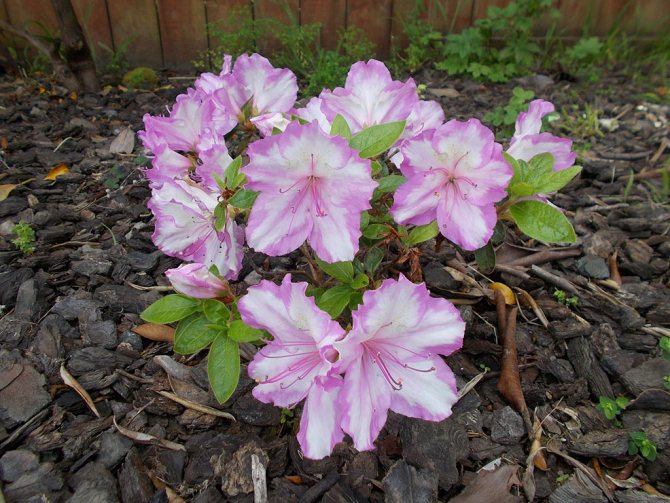

Unique plant care during the flowering period
Important! In the process of spraying the leaves, you need to minimize the ingress of moisture on the petals and buds of the azalea.
It is advisable to watch out for dry leaves and already faded buds. They need to be removed so that the feed goes to other parts of the plant. It is not advisable to prune branches at the time of active growth, this can lead to drying out and even death of the garden rhododendron.
Into a notebook.
Heather soil - the upper layer of forest litter 10-20 cm thick, including part of the primary soil, from an old pine or spruce forest, in the lower layer of which such species as lingonberry, heather, wild rosemary, bilberry, cranberry, blueberry, etc. grow. It is useful to add heather soil under all heather rhododendrons little by little, but constantly, thus imitating the process of fertilizing heathers in nature with coniferous litter. Heather soil has an acidic reaction, is rich in organic matter and is inhabited by mycorrhiza of useful fungi, usually protozoa.
Coniferous litter is the upper, organic component of heather land, including both completely decomposed needles and recently fallen needles. Coniferous litter loosens and acidifies the soil.
Heather compost - is prepared from heather soil, coniferous litter, pine, spruce or larch bark, rotten stumps, sphagnum, high peat, sand, small coniferous twigs, leaves of forest trees, etc. These components are laid in layers somewhere in a shady damp lowland, in a wide pile 50-70 cm high. The top of the pile is formed trough-like to delay precipitation. The compost is stored for several years until the branches and bark are completely decomposed, that is, until it turns into a homogeneous free-flowing mass.
Choosing a place. Illumination is chosen individually for each specific species and variety. In general, deciduous rhododendrons are more sun-loving, while evergreens prefer diffuse or inconsistent partial shade. So that the soil does not dry out much, you should not allocate slopes for rhododendrons. The subsoil, for the same reasons, is better loamy than sandy. It should also be remembered that most rhododendrons do not like drying winds, so the landing site must be protected.
Soil preparation. There is no soil that all rhododendrons, without exception, would agree to. Still, most of them love the presence of peat in the soil. You will not be mistaken if you pile a half-meter layer of high-moor peat on the existing soil and shove it all well 50-60 cm deep. This will already ensure the well-being of rhododendrons by 80%.
To please one hundred percent, it is necessary to populate the soil with mycorrhiza of microscopic fungi, with which heathers are in mutually beneficial symbiosis.Fungal organisms help heathers extract and process the nutrients they need from acidic substrates that are unsuitable for other plants. To introduce the necessary mycorrhiza, it is necessary to add to the soil "leaven" - coniferous or heather soil - the upper (10-15 cm layer) part of the forest litter taken from an old pine forest, in the lower tier of which there are such species as heather, wild rosemary, lingonberry.
The soil substrate can also be created separately by mixing high peat, turf, sand and heather soil in a ratio of 4: 1: 1: 2 or 4: 1: 1: 1.
Planting and transplanting. Rhododendrons usually tolerate transplanting well, provided that the soil is properly prepared and constant moisture is provided. In a rainy period, you can risk transplanting a bush with a lump of earth even in the middle of summer. Of course, the seedling in the container doesn't count at all. With bare roots and without a coma, rhododendrons tolerate transplantation better in autumn, when the favorable period for this is much longer than spring.
Care. All heathers (except for rhododendron, garden crops such as blueberries, cranberries, lingonberries, whitewash, heather, wild rosemary, etc.) can be attributed to this group, on the basis of which they should be grown separately from other plants. In addition to the mushroom mycorrhiza they need, they have superficial roots, so they do not tolerate digging. It is advisable to fertilize rhododendrons by mulching, regularly pouring moor peat, heather soil, pine or spruce needles, crushed bark and sawdust of coniferous species into its foot. For this, it makes sense to constantly import coniferous soil, coniferous litter from the forest, prepare heather compost according to the above recipe. It is advisable to add these components alternately 3-4 times per season in small doses under the rhododendrons. Then the substrate feeding the plants will constantly grow, and the rhododendrons will have everything they need to thrive. In essence, the same thing, only much more slowly, occurs in nature as a result of natural processes.
Understanding the terminology
Botanists abolished the separate genus Azalea and merged them with the genus Rhododendron. These plants are part of the Heather family. It would seem that we do not need to know such subtleties, but it is important when buying plants and when determining the conditions for their comfortable existence.
Some gardeners call azaleas the thermophilic representatives of this family living on the windowsills of our apartments, and when they say rhododendron, they mean a garden plant. But confusion often occurs, and therefore both names can be found on the planting material.
Popular fertilizers
The most effective top dressing for rhododendron, according to experienced gardeners, is a potassium phosphate buffer solution. The composition contains the main macronutrients and substances useful for maintaining the acidity of the soil. The nutrient mixture is prepared in proportions of 8 g of potassium nitrate and monobasic potassium phosphate per 10 liters of water.
For single cultivation of "rosewood" solutions of mineral salts are relevant. For mass planting of a flower culture, dry tuk is used:
- superphosphate 20 g;
- potassium sulfate 20 g;
- ammonium sulfate 40 g.
80 g of dry mixture in early spring is applied under a bush with a height of 1 m. After the flowering phase, feed is repeated in a half dose.
The specificity of long-acting preparations provides for the gradual replenishment of the flower culture over a certain period of time with a single application.
Pokon
The drug is relevant for planting young seedlings, it is also effective as spring feeding. The granules are introduced into the near-stem circle, slightly mixed with the surface substrate, and watered abundantly. For 1 bush, 30 g of the drug is consumed once a season. Pokon is available in 900g packs.
ASB-Greenworld
The remedy is indicated for ornamental vegetation that grows in an acidic environment. With the help of the drug, the growth and development of culture is stimulated, the budding process is accelerated, the color of the foliage is improved, the flowers also acquire a rich color. Apply according to the instructions every 3 months.
Agrecol
When planting, 10-50 g of the product are consumed, depending on the size of the seedling. To feed adult plants, add granules under the bush and lightly cover with soil mixture, followed by abundant watering:
- flower crops with a height of more than 1 m - 60 g for each meter of growth;
- bushes up to 70 cm - 70 g for a plant;
- low stands - 50 g per bush.
To ensure optimal nutrition of rhododendrons, fertilize is applied 2 times per season with an interval of 3 months.
Important! Sustained-release granular fertilizers are designed for climatic zones with 6 months of warm weather. The use of the drug in cold regions leads to secondary growth of shoots at the end of summer, which is fraught with freezing.
When should you shoot?
In the spring, when the warmth comes, you can remove the shelter from the rhododendrons. Not only air, but also the earth should warm up at the time of opening of the shrubs., because when the air has already warmed up well, and the ground is still frozen, the leaves begin to evaporate moisture, and the roots cannot yet get it. Drying of the plant begins. To speed up the process of thawing the soil, it is necessary to water the rhododendron.
Reference. It is possible to open rhododendrons only on a cloudy day, since the leaves weakened during the winter are afraid of burns from the bright spring sun.
How to understand that there is a need?
- A change in the color of the leaves (they become light, yellowish, lose their gloss) is always an alarm signal: the azaleas do not have enough nutrition.
- A sign of a lack of micro- and macroelements after flowering is also a slight increase in young shoots (these are green, non-lignified shoots) and massive leaf litter even on evergreen varieties.
- Flower buds are not laid at all or there are few of them - also evidence that the azalea needs mandatory feeding.

